Myron G. Best. Igneous and metamorphic 2003 Blackwell Science
Подождите немного. Документ загружается.


Metamorphism at Convergent Plate Margins: P–T–t Paths, Facies, and Zones
567
P–T conditions resulting from lack of attainment of
equilibrium in the mineral assemblage, difficulties in
interpreting relict mineral assemblages by the petrolo-
gist, inaccuracies in thermobarometric analyses accru-
ing from poor thermodynamic data and calibration or
improper methodology, and other factors.
Geochronology and Time-T Paths. To place a P–T
path in an absolute time frame there must be age de-
terminations at distinct points on the path using iso-
topic systems. Several isotopic systems and minerals
are potentially useful. However, unlike quickly cooled
volcanic rocks, metamorphic rocks typically experience
(a) 42 My elapsed
0
50
100
0
50
100
(b) 75 My elapsed
km
km
0
50
100
0
50
100
4003002001000
4003002001000
200
400
600
800
1000°C
Greenschist
Granulite
Blueschist
Amphibolite
Granulite
Eclogite
200
400
600
800
1000°C
Greenschist
Amphibolite
Granulite
Eclogite
18.2 Finite-element tectonothermal model of a continent–continent collision zone, courtesy of Gregory T. Roselle. The model is appro-
priate for the late Cretaceous–Tertiary Alpine Orogen. Upper, middle, and lower layers of continental crust have thicknesses of 5, 11,
and 24 km and their radioactive heat generation is 1.8, 1.0, and 0.2 microwatts/m
3
, respectively. Heat generation in the mantle is
0.02 microwatts/m
3
. (a) After 42 My of convergence at an average rate of 0.8 cm/y and no erosion. In top panel, isotherms are deflected
downward in the overriding plate as a result of the heat-sink effect of the cooler upper layer of the subducting slab. Bottom panel shows
distribution of metamorphic facies. (b) After 75 My of convergence at an average rate of 0.17 cm/y and an average erosion rate of
0.27 cm/y after 60 My. Isotherms are warped upwards in overriding plate where slices of radioactively enriched upper crust from the
subducting slab (triangles) have been tectonically inserted and almost exhumed by erosional unroofing. In the distribution of meta-
morphic facies in the bottom panel it can be noted that no blueschist facies is present because of the increased heating that has brought
amphibolite- and granulite-facies conditions closer towards the surface. Compare Figures 14.33 and 18.1.
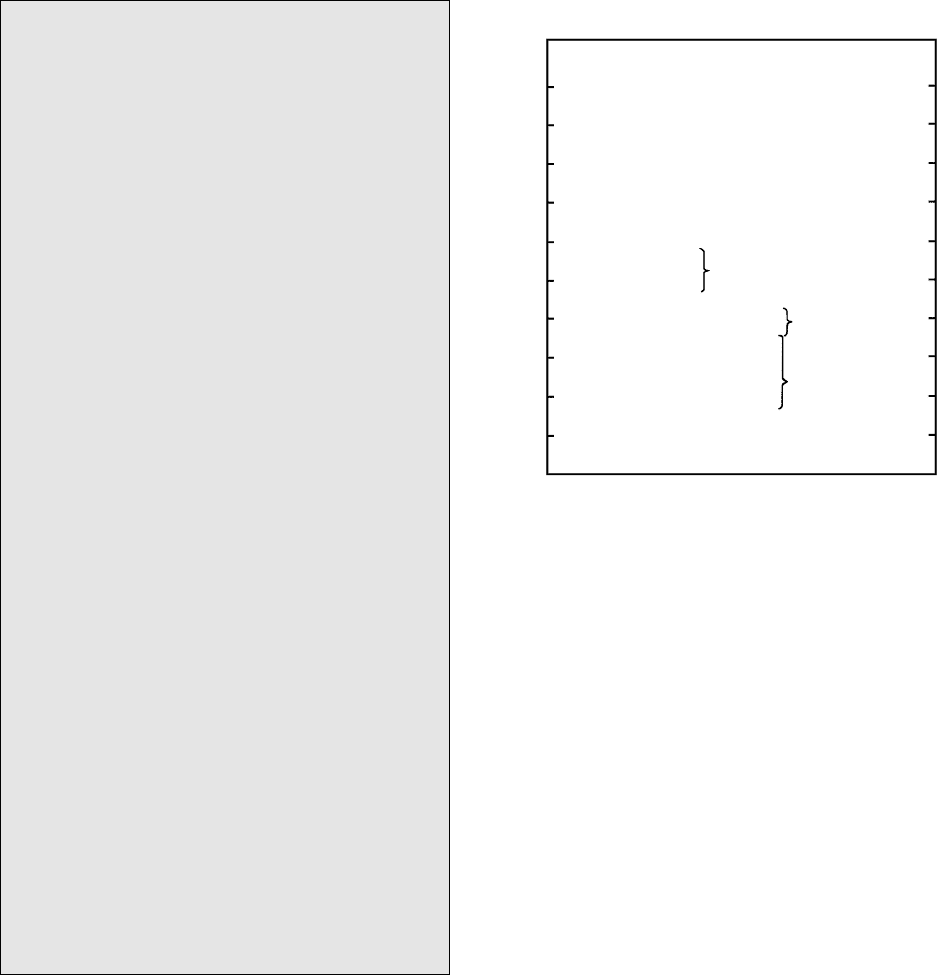
slow decreases in T from peak conditions, with con-
sequent ample opportunity for differential loss or gain
of both parent and daughter isotopes (Section 2.6)
because of their typically dissimilar chemical behavior.
This open-system behavior is extreme in the case of
decay of radiogenic
40
K to
40
Ar, an inert gas which has
no chemical bonding to any crystal structure and,
therefore, can readily diffuse out of the host potassic
mineral. But daughter atoms in any isotope system are
subject to a degree of diffusion that decreases continu-
ously and exponentially with decreasing T. The T at
which the rate of diffusion is effectively nil where the
isotope system becomes closed is called the closure
temperature, T
c
. Some of these are shown in Figure 18.3
where it can be noted that a useful low T
c
chronologic
system involves fission tracks in apatite and zircon.
During fission of radioactive U atoms incorporated
into a growing crystal, outward flying decay particles
damage the surrounding atomic structure in the host
crystal grain. These damage tracks can be enhanced
chemically so as to be made visible under high-power
optical magnification; the proportion of countable
tracks to the determinable U-concentration in the
crystal allows an age to be obtained. Fission tracks
are annealed by internal recrystallization and hence
eliminated above the respective T
c
of the mineral.
Because different isotopic systems in different min-
erals have different closure temperatures, a T–t path
can be constructed for a rock, or set of coeval rocks,
that contain the different systems. As the rock cools be-
low the T
c
of a particular isotope–mineral system, the
time of closure—when the “clock” is started—can be
determined. Two or more such determinations give a
cooling rate for the rock.
Numerous examples of P–T–t paths have been
described and representative ones are shown in later
sections. Paths can be relatively open loops that corre-
spond to continuous changes in both P and T or tight
“paper-clip” loops where the retrograde path closely
568 Igneous and Metamorphic Petrology
Special Interest Box 18.1 Low-grade
active metasomatism in a continental
geothermal field
Synextensional magmatism related to spreading in
the Gulf of California has created the Cerro Prieta
geothermal field in the Salton Sea area just south of
the California–Mexico border (Figure 13.29; see
also Schiffman et al., 1984). Carbonate-cemented
quartzo-feldspathic sediments are being actively
metasomatized into calc–silicate mineral assemblages
by reaction with alkali–chloride-rich hydrothermal
solutions, or “brines,” at depths 2.5 km and tem-
peratures (determined from oxygen isotope ratios
in calcite) between 200 and 370°C. Advection of
the solutions is presumed to be driven by heat from
buried intrusions. Drill cores and cuttings from
50 wells constrain the conditions of metasoma-
tism and equilibrated mineral assemblages (Figure
18.18). X in the fluid declines below about 0.5
with increasing T. Because of buffering by car-
bonaceous material in the sediments, f is slightly
more reducing than QFM (Figure 3.14). Time-
integrated fluid–rock ratios are about 3. The lowest
T decarbonation reaction just below 200°C yields
the Ca–zeolite wairakite from the assemblage of
calcite (cement) and (detrital) illite, quartz, feldspar,
and chlorite. At about 230°C, epidote forms from
calcite wairakite followed by prehnite actino-
lite at about 300°C by decomposition of calcite
chlorite. The highest T minerals, clinopyroxene and
biotite, appear at 320°C either by the dehydration
of actinolite prehnite (yielding also epidote) or
by the mixed fluid reaction actinolite calcite →
clinopyroxene H
2
O CO
2
. The distinctive
low-P assemblage of clinopyroxene epidote
prehnite has been found in a wide range of pro-
toliths in other geothermal systems. Significantly in
this commercial geothermal field, devolatilization
reactions create secondary porosity.
O
2
CO
2
T (°C)
1000
800
600
400
200
0
Zircon
Monazite Grossular
Allanite
Almandine garnet
Muscovite
Pyrope
Rutile
Apatite
Biotite
K-feldspar
Hornblende
Muscovite
Biotite
K-feldspar Titanite
Zircon
Apatite
U-Pb Sm-Nd Rb-Sr Ar
Fission
track
18.3 Closure temperature, T
c
, for some common minerals used in
geochronology according to the isotopic systems indicated
across the top of diagram. Data from Hodges (1991), Thom-
son et al. (1998), and personal communication from Stephen
Nelson and Bart Kowallis. For a given mineral and isotopic
system, T
c
depends on cooling rate and effective distance of
diffusion to a free surface in the mineral grain.
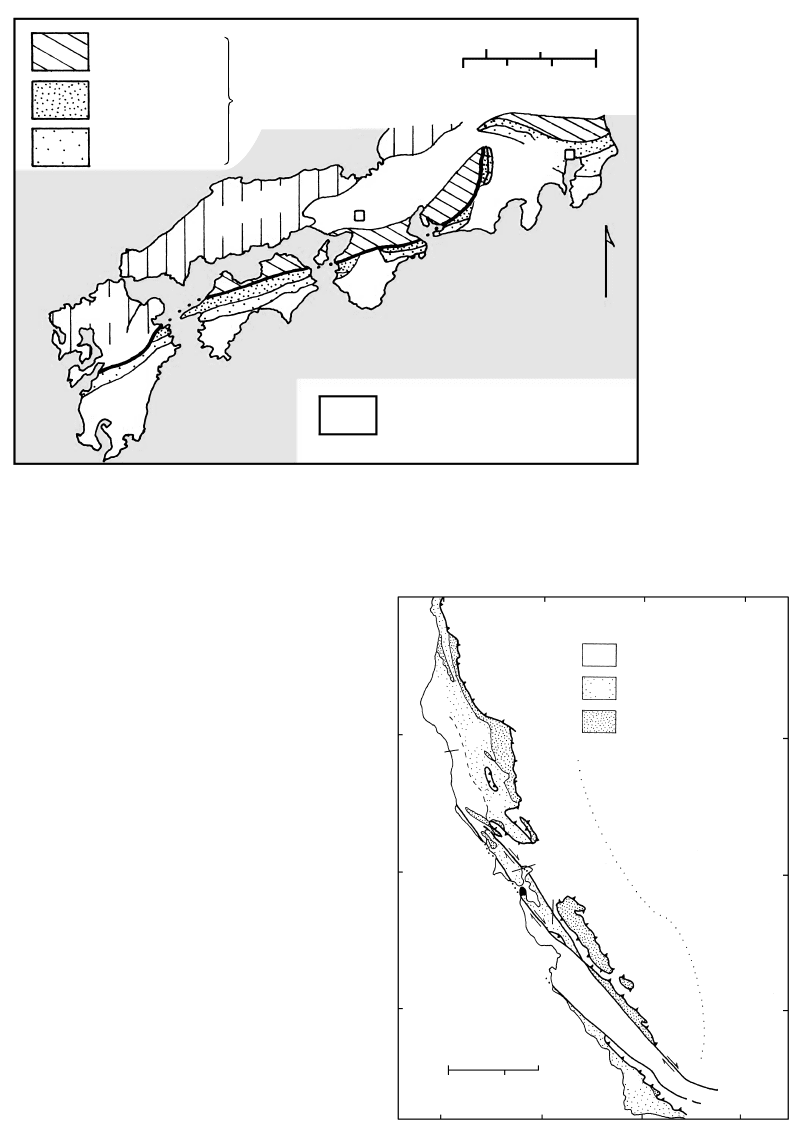
follows the prograde. Like phase equilibria, published
P–T paths have differing degrees of accuracy and
reliability. They must be viewed with caution and a
bit of skepticism. Spear (1993, p. 766) concluded that
“It is the obligation of every petrologist to apply
rigorous methods to the analysis of petrogenesis and
to try not just to obtain a P–T path, but to analyze
its certainty.” His treatise explains how this can be
accomplished.
18.2 A BRIEF ANATOMICAL OVERVIEW
OF METAMORPHISM IN OROGENS
No two orogens are exactly alike and neither are the
metamorphic terranes in them, making it difficult to
create a brief but accurate generalized summary.
As early as 1961, before plate tectonic concepts
were fully established and accepted, Miyashiro (see
1994) recognized that metamorphic mineral assem-
blages in Japan define two juxtaposed, side-by-side
metamorphic terranes, or paired metamorphic belts
(Figure 18.4). South of a major fault zone—the Median
Tectonic Line—and adjacent to the trench bordering
the Pacific are rocks of the Shimanto–Chichibu–
Sanbagawa Belts metamorphosed to the zeolite and
prehnite–pumpellyite facies and culminating in higher
P rocks transitional to the blueschist facies. Farther in-
land, north of the Median Tectonic Line, are rocks of
the Ryoke Belt metamorphosed to lower P facies. On
the opposite side of the Pacific Ocean, in California
alongside the now active right-lateral San Andreas con-
tinental transform fault (Figure 18.5), rocks of the high
Metamorphism at Convergent Plate Margins: P–T–t Paths, Facies, and Zones
569
Ryoke Belt;
intermediate P/T
Sanbagawa Belt;
high-P preh.-pump.
Chichibu Belt;
prehnite-pumpellite
Jurassic
0
0 miles 150
km 200
Kyoto
Jurassic
JAPAN
SEA
Pre-
MTL
PACIFIC OCEAN
N
Tokyo
Z
Z
Z
Z
Z
Z
Shimanto Belt; zeolite
facies; Cret.–Tertiary
18.4 Accreted terranes and their metamorphism in Japan. Terranes were accreted at progressively later times from north to south. The strike-
slip Median Tectonic Line (MTL) separates the higher T intermediate-P Ryoke belt from the high P/T prehnite–pumpellyite-facies
Sanbagawa–Chichibu Belts. Redrawn from Miyashiro (1994).
42°N
40°N
38°N
36°N
124°W 122°W 120°W 118°W
0 100mi
0 100km
p
Ocean
Pacific
Great
Sierra
Nevada
Valley
San
Francisco
p
p
p
z
z
p
z
p
Laumontite (zeolite)
Metamorphic facies
Pumpellyite
Glaucophane–
lawsonite (blueschist)
Klamath
Mountains
18.5 Simplified geologic map showing high P/T metamorphic
zonation in the Franciscan Complex in the California Coast
Ranges. Heavy lines with teeth are traces of the Coast Range
Thrust; teeth are on upper plate rocks of the Great Valley
Sequence (unpatterned). Postmetamorphic, mid- to late-
Cenozoic faults of the right-lateral San Andreas transform sys-
tem are unpatterned heavy lines. Note Sierra Nevada farther
inland where calc–alkaline arc magmatic rocks are associated
with intermediate-P metamorphic rocks. Redrawn from Ernst
(1975).
P/T facies series (zeolite, prehnite–pumpellyite, and
blueschist) are found in the Coast Ranges. Farther in-
land, rocks of the intermediate P/T facies series (green-
schist and amphibolite) are spatially associated with
granitic rocks of the Mesozoic Sierra Nevada Batholith.
In the plate tectonic model in Figure 14.24, the polar-
ity of these two paired Mesozoic–Cenozoic metamor-
phic belts results from tectonothermal phenomena
associated with subducting oceanic lithosphere. The
higher P/T rocks in the accretionary wedge next to the
trench lie immediately above the cool subducting plate
that acts as a heat sink, maintaining temperatures well
below the granite solidus, thus essentially precluding
any migmatization and magmatism, and creating steep
metamorphic field gradients. Rocks metamorphosed
along lower P/T field gradients lie farther inland from
the trench in thickened and heated continental crust
where calc–alkaline arc magmatism and deep crustal
migmatites testify of elevated temperatures. Ernst
(1973) points out that the polarity of field gradients
and facies series can be applied to ancient subduction
zones where active seismicity and plate motions no
longer exist to indicate the direction of dip of the
descending lithospheric slab.
However, it is difficult to invoke this simple plate
tectonic model for every orogen. Even in Japan, the
Median Tectonic Line has experienced significant left-
lateral strike-slip displacement accompanying oblique
convergence of the paired terranes; this opens the pos-
sibility that the Ryoke and Sanbagawa–Chichibu Belts
were not created side by side as adjacent paired trench
and inland terranes but were formed contemporane-
ously along strike (Brown, 2000).
A major complication in the evolution of orogens
arises where, as commonly happens during the course
of plate motions, an oceanic island arc or plateau clogs
a subduction zone or where two continental plates of
any size converge on one another in a collision zone. In
the Cordilleran Orogen of Alaska, high P/T rocks are
associated with accretionary wedges and oceanic plate
convergence as well as with collisional continental
plates. These oceanic and continental terranes were su-
tured onto the North American Plate as early as the
Permian and continued episodically and diachron-
ously through the Cretaceous (Patrick and Day, 1995).
Because high P/T rocks occur far inland, the simple
metamorphic-belt polarity recognized to the south in
California does not apply. As oceans close during the
evolution of convergent plate systems, thicker contin-
ental lithosphere can collide with the overriding con-
tinental plate. This happened during the Paleozoic in
the Appalachians in eastern North America and the
Urals in central Russia, during the late Cretaceous in
the Alps in Europe, and the Cenozoic in the Himalayas
in southern Asia. Hence, metamorphic terranes formed
in different settings along different P–T paths and at
different times can be closely juxtaposed and sutured
together into a thickened collage that undergoes fur-
ther deformation, metamorphism, and possible mag-
matism, typically over hundreds of millions of years.
In the Alps, metamorphic terranes have evolved in a
complex manner as northern and southern continental
plates collided (see Tauern Window below).
The Appalachian Orogen (Figures 13.26 and 18.7;
see also Blatt and Tracy, 1996, p. 390) from Alabama to
Newfoundland contains rocks metamorphosed and
deformed as early as 525 Ma during the Taconic
Orogeny when the ancient Iapetus Ocean closed and a
converging continental mass trapped trench, accre-
tionary wedge, and island arc rocks in the broad suture;
ocean-derived ophiolites are particularly evident in
Newfoundland. Metamorphism in the thickened crust
along intermediate-P field gradients and clockwise
P–T paths yielded Barrovian zones from greenschist
through granulite facies. Relict blueschist- and eclogite-
facies rocks have been found in only a very few
locales in the Appalachians, probably because of
widespread overprinting by subsequent higher T equi-
libration but possibly also because the seaward high
P/T rocks were rifted away during the Mesozoic open-
ing of the Atlantic Ocean. Subsequent orogenic pulses
resulting from colliding continental masses produced
metamorphism and deformation at 420–370 Ma and
320–270 Ma. The earlier of these two pulses—the
Acadian—was especially significant in the northern
Appalachians. Barrovian metamorphism in the western
part of New England partly overprinted earlier Taconic
assemblages, whereas in east-central New England and
adjacent Canada lower P Buchan zones developed.
Later Alleghanian metamorphism (320–270 Ma) was
felt throughout the length of the orogen but is mostly
of greenschist- or lowest amphibolite facies.
18.2.1 Specific Regional Metamorphic Terranes
Terranes of mineralogically and texturally zoned tec-
tonites typify orogenic belts. Some of these terranes are
of such distinct character and evolution as to warrant
specific names. Those occurring in the intermediate- to
low-P Barrovian and Buchan terranes (see Section
18.3) are described next.
Slate belts are prominent features of most orogens.
For example, the Appalachian Mountains of eastern
North America harbor multiple belts that individually
are as much as 50 km wide and hundreds of kms long
(Figure 18.8). Although dominantly metamorphosed
shales, other aphanitic tectonites derived from sedi-
mentary and volcanic protoliths are interspersed in
slate belts. The typifying slaty cleavage is generally
steeply inclined and subparallel to the belt; local over-
printing spaced cleavage (Figure 14.18) is common.
Mineral assemblages are generally of the subgreen-
schist and lower greenschist facies.
570 Igneous and Metamorphic Petrology
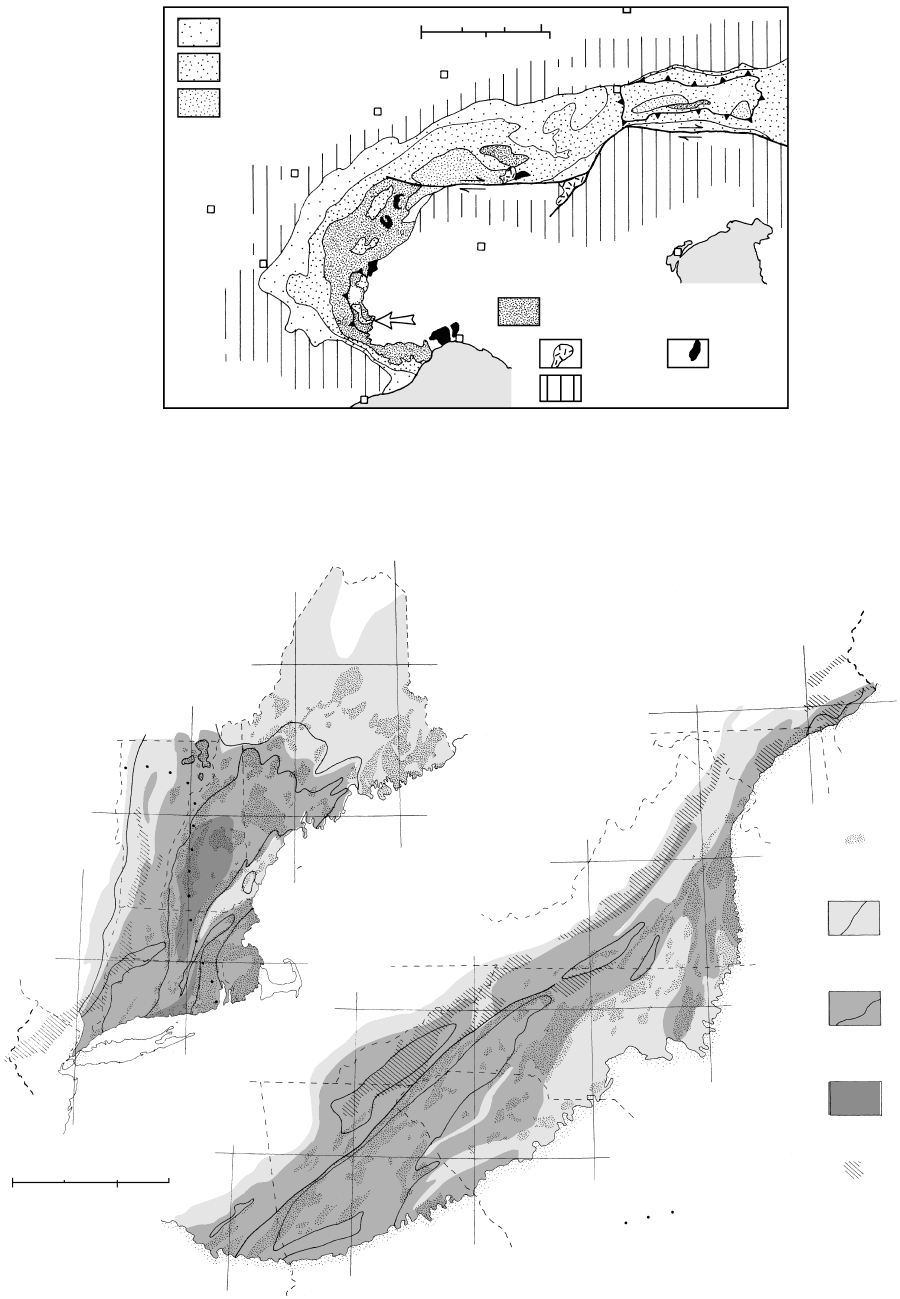
Amphibolite facies
GENEVE
LYON
D
Zeolite and prehnite–
pumpellyite facies
Greenschist facies
0 km 150
0 miles 200
MÜNCHEN
ZÜRICH
BERN
´
MONACO
LIGORIAN
SEA
GENOVA
HP and UHP assemblages
overprinted by greenschist facies
Alpine
granitoid
Folded rocks; not
metamorphosed
Ultramafic
rocks
MILANO
VENEZIA
ADRIATIC
SEA
Line
TW
INNSBRUCK
Insubric
GRENOBLE
18.6 Distribution of late Cretaceous–early Tertiary Alpine metamorphic zones and facies in the western Alps (see also Figure 18.24). Note the
scarcity of ultramafic rocks and virtual absence of Alpine-age granitoids in this continent–continent collision zone. The Insubric Line is
a late, mostly post-metamorphic, steeply dipping fault that has considerable right-lateral strike-slip displacement. The Tauern Window
(TW) in Austria and the Dora Maira Massif (D) in northwestern Italy near the border of France are important metamorphic terranes
exposed by erosion of domical Oligo-Miocene upwarps. Arrow shows location of UHP rocks in the southern part of the Dora Maira
Massif. Redrawn from Frey et al. (1974).
Granitic intrusions
(chiefly postmetamorphic)
Greenschist facies
with biotite (b) isograd
Amphibolite facies
with sillimanite (s) isograd
Granulite facies
Precambrian
metamorphic rocks
0 150miles
0 160km
Atlantic
Ocean
42°N
74°W
46°N
70°W
bf
Cretaceous
and
Tertiary
rocks
36°N
40°N
84°W
80°W
76°W
bf
bf
Brevard
fault mylonite
zone
Trace of Al
2
SiO
5
triple point
b
s
18.7 Generalized map of regional metamorphism in the Appalachian Orogen of the eastern USA. The New England segment (top) joins onto
the central and southern segment (bottom) along the Pennsylvania–New Jersey state line (heavy dashed line). Redrawn from Morgan (1972).
Regional Metamorphism in Subduction Zones: P–T–t Paths, Facies, and Zones 571
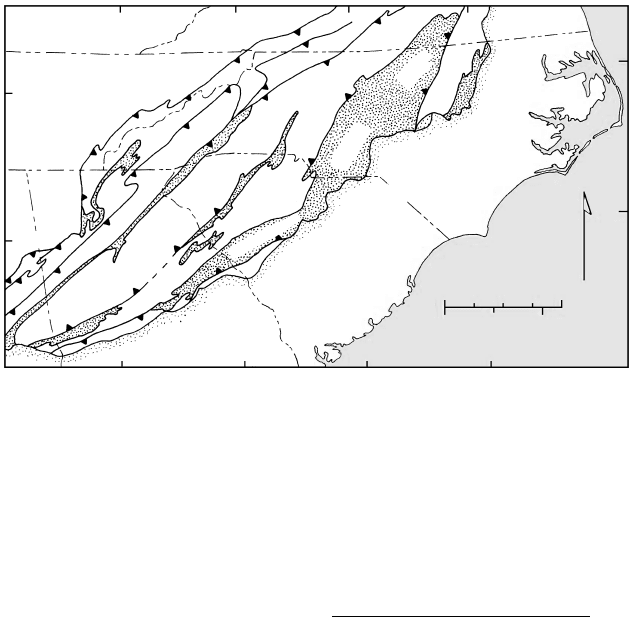
Mantled gneiss domes (Eskola, 1949) found in the
deeper, ductile, higher grade metamorphic cores of
orogens are overlain by essentially concordant but
locally folded layers of schist, amphibolite, and other
metamorphic rocks. Belts of such domes occur in
many deeply eroded orogens, such as the northern
Appalachians (Figure 18.9). Buoyant upward mush-
rooming of core granitic orthogneisses in the con-
tractional orogenic environment deforms covering
rocks into large-scale recumbently folded nappes.
(Recumbent folds are strongly overturned so that their
axial surfaces are nearly horizontal. Nappe is French
for “coversheet” and was coined for fold and
thrust-sheet structures in the Alps.) In mushrooming
migmatite domes, buoyancy is enhanced by partial
melting of the high-grade metamorphic rock. Spec-
tacular examples occur in the rugged mountainous
terrane of the East Greenland Caledonide Orogen
(Figure 18.10).
The astute reader will realize that there is little
difference in the creation of mantled gneiss domes,
migmatite domes, and granitic diapirs (Section 9.3;
Figures 9.15 and 9.21). All are buoyant masses that
dome overlying roof rocks during their ascent into
or through the low-ductile-strength lower continental
crust. Gneiss and migmatite domes can be viewed as
a continuum depending on the degree of partial
melting, but whether the more melt-rich granitic
diapirs can be derived from migmatite by more
advanced melting is controversial. Many petrologists
believe migmatites do not evolve into granite plutons.
Instead, they view migmatites as “failed” granites, in
part because the small volumes of hydrous partial melt
are likely to crystallize across a negatively sloping
solidus (in P–T space) before rising very far from the
source.
Metamorphic core complexes. Controversial domal
structures along the eastern side of the Mesozoic–
early Cenozoic Cordilleran Orogen of western North
America (Figure 18.11) are possible shallow crustal
expressions of gneiss domes. These metamorphic core
complexes are composed of Precambrian to Cenozoic
metamorphic and magmatic rocks overprinted by com-
plex, polyepisodic magmatic intrusion, metamorphism,
and ductile to brittle deformation. A tectonically
detached and distended cover of unmetamorphosed
rocks is exposed on the flanks of the uplift but mostly
eroded from off the uparched core. Features com-
mon to most or all include (Crittenden et al., 1980;
Armstrong, 1982):
1. Tectonic denudation (unroofing) from the Pale-
ocene to mid-Miocene accomplished by low-dip-
angle extensional faulting that began in the ductile
regime, producing mylonite, but culminated in the
brittle regime, producing cataclastic fabric. The
actual timing and development of the ductile versus
brittle shearing depended on local variations in
thermal regime and strain rate.
2. Unmetamorphosed rocks tectonically overlie a
domed core of metamorphosed rocks intruded by
granitoids—hence, metamorphic core complex.
The grade of metamorphism is variable in the core.
3. Prominent low-dip, ductile to brittle, foliation sub-
parallel to the denudation faults. Axes of local, re-
cumbent, isoclinal (limb-parallel) folds are parallel
to a strong pervasive stretching lineation on folia-
tion surfaces. Flattening above an upwelling gneiss
572 Igneous and Metamorphic Petrology
36°N
34°N
82°W78°W
0 miles 100
0 km 200
N
Virginia
Kentucky
Tennessee
Georgia
INNER
BLUE
PIEDMONT
SLATE
BELT
RIDGE
CAROLINA
P
O
S
T
-
O
R
O
G
E
N
I
C
(
C
R
E
T
A
C
E
O
U
S
-
T
E
R
T
I
A
R
Y
)
S
E
D
I
M
E
N
T
A
R
Y
R
O
C
K
S
PROVINCE
V
A
L
L
E
Y
A
N
D
R
I
D
G
E
South
Carolina
North
Carolina
Ocean
Atlantic
18.8 Generalized geologic map of the southern Appalachian Mountains showing slate belts (heavy stippling) interspersed with higher grade
metamorphic rocks, such as in the Inner Piedmont, and sedimentary rocks to the northwest. Major thrust faults shown by lines with teeth
on upper plate. Redrawn from Weaver (1984).
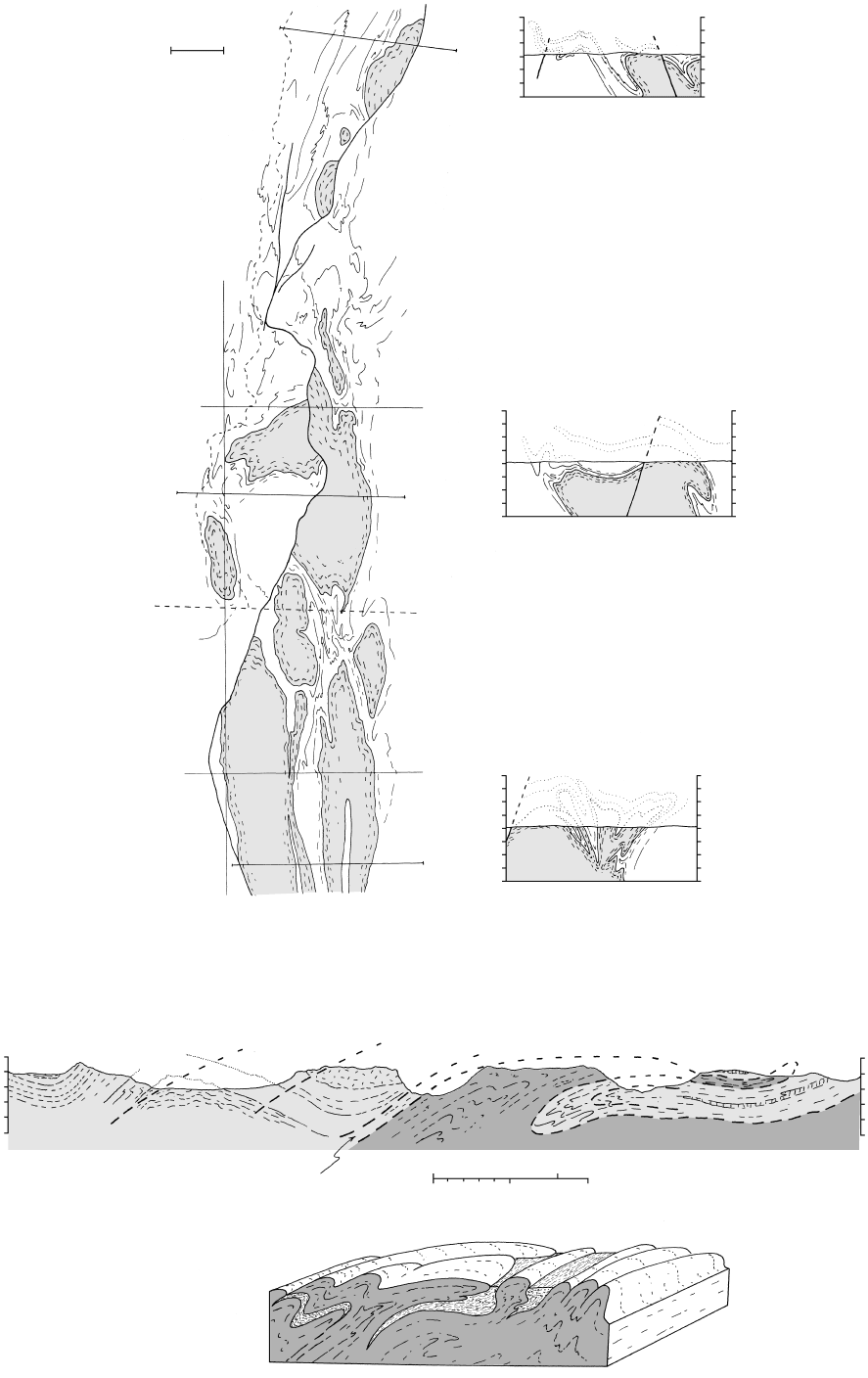
6
6
km
s.l.
6
6
km
s.l.
6
6
km
s.l.
Mass.
Vt.
42°30N
BB
B
B
CC
C
C
A
A
A
A
43°00N
72°30W
05mi
08km
Vt
N H
18.9 Generalized geologic map and cross sections showing mantled gneiss domes (shaded) and overlying fold nappes in the New England
Appalachian Orogen. See Figure 18.7. Dashed lines show foliation in margins of domes. Longer lines and dotted lines in cross-sections
show complex recumbent fold nappes in metamorphic rocks mantling domes. Heavy lines are postorogenic (Triassic) faults. Redrawn
from Thompson et al. (1968).
3
km
s.l.
2
3
km
s.l.
2
05mi
010km
Sedimentary
rocks
Metamorphic rocks
Chlorite
Biotite
garnet
Biotite garnet
plagioclase
Staurolite
kyanite
Migmatites
Migmatites
18.10 Migmatite domes and nappes in the Caledonide Orogen in east Greenland. (a) Geologic section across the head of Kejser Franz Joseph
Fjord. Note that horizontal and vertical scales are the same: s.l., sea level. (b) Interpretive model of formation. Redrawn from Haller (1971).
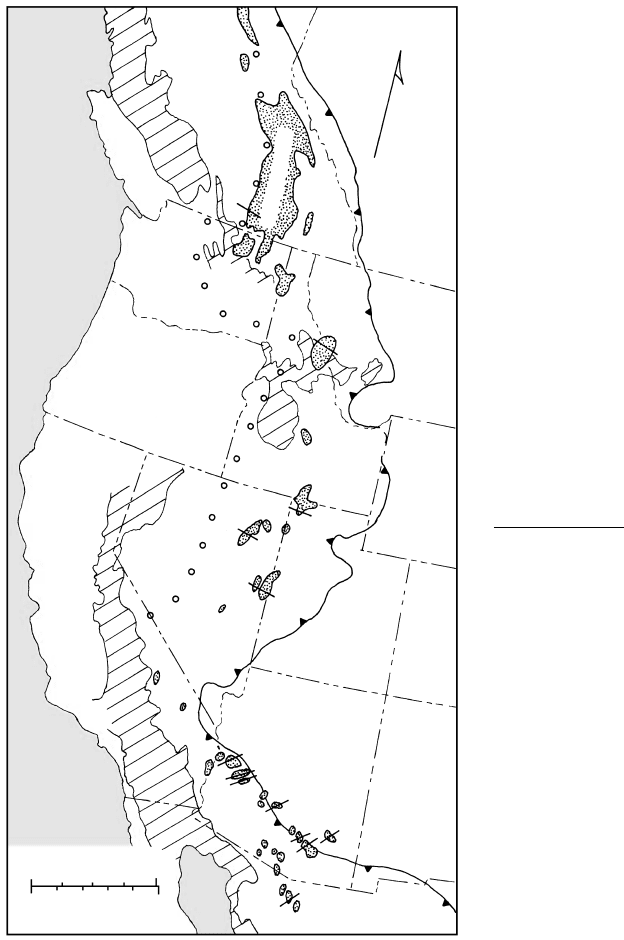
dome or simple shear (Figure 17.21) or both may
have created the metamorphic foliation and lin-
eation. Strain in these L-S tectonites is extreme
(Figure 14.13 and Problem 14.1).
4. Broadly syntectonic, Cretaceous to early-Cenozoic
granitic intrusions in the metamorphic core that are
variably overprinted by ductile–brittle shearing.
Many granitoids are peraluminous and have rela-
tively radiogenic Sr-isotope ratios; both of these
properties are consistent with magma generation
from, or at least assimilation of, metasedimentary
rock.
The timing of development of the core complexes
following Mesozoic–earliest Cenozoic thrusting and
their spatial distribution in the belt of overthrusts onto
the Precambrian cratonic margin of the continent (Fig-
ure 18.11) are probably no coincidence. All thermal
models of thickened crust indicate significant heating
resulting from thermal relaxation that culminates tens
of millions of years following thrusting. It is not
unreasonabe to suppose that heating may have been
sufficient to generate crustal magmas whose buoyant
ascent created mantled gneiss domes in the deep crust
and core complexes in the shallower crust.
Tauern Window. This classic domical structure in the
eastern Alps (Figure 18.12) exposes high-grade rocks
of the Penninic nappes beneath a low dipping tectonic
carapace of lower grade Austroalpine nappe rocks.
As will be seen, in some respects, the Tauern Window
resembles Cordilleran metamorphic core complexes.
The Alpine Orogen is a result of convergent tecton-
ism. Southward subduction of a European (Tethys)
oceanic basin beneath the southern (Adriatic) conti-
nental plate during the late Cretaceous was followed
by continent–continent collision in the early Tertiary.
Metamorphosed and deformed European plate oceanic
rocks are represented in the Penninic nappes, while
the Austroalpine rocks represent the southern con-
tinent. Thickening of the continental crust during
collision created the regional Alpine metamorphism
(Figure 18.6).
In this tectonic scenario, it is not surprising that the
tectonic contact between the two nappe sequences in
the Tauern Window has been conventionally interpreted
to be a thrust. However, some geologists are beginning
to recognize evidence for late Cenozoic tectonic thinning
and unroofing along low-dip-angle extensional (nor-
mal) faults. If this extensional activity is sigificant, it
impacts the tectonic and metamorphic evolution of the
Alps. Do the metamorphic rocks in the window furnish
any insight into these conflicting interpretations?
Selverstone (1988) has documented consistent
shear-sense indicators in strongly lineated tectonites in
the western part of the window that indicate ductile
thinning and extensional shearing of an overriding
carapace moving westward. The fabric indicators in-
clude rotated garnet porphyroblasts, asymmetric augen
and strain shadows, and S–C fabric (Section 17.3.5;
Figures 17.30 and 17.35).
574 Igneous and Metamorphic Petrology
Pacific
Ocean
Arizona
Colorado
New
Mexico
Wyoming
Idaho
Utah
Nevada
California
Washington
Oregon
Alberta
Montana
SHUSWAP
Mexico
0 km 400
0 miles 250
British
Columbia
N
18.11 Metamorphic core complexes in western North America.
Core complexes (heavy stippling) lie within the belt of Meso-
zoic overthrusts (eastern limit marked by line with teeth on
upper plate) on buried margin of continental craton (western
limit shown where documented by open circles). Line seg-
ments in core complexes represent prominent lineations that
are oriented approximately perpendicular to belt. Major
Mesozoic granitic batholiths (Figure 9.16) shown by diagonal
ruling. Large areas of mostly late Cenozoic volcanic rocks
omitted for clarity (but see Figures 10.13 and 13.29). Redrawn
from Armstrong (1982).

Innsbruck
N
schist
Lower
Central gneiss
Upper
schist
Eclogite
0km 30
0 miles 20
(a)
(b)
NS
P
80–70 Ma
62 Ma
30 Ma
20 Ma
U
L
E
E
L
U
E
U
L
LEU
LEU
U
L
E
E
L
U
E
U
L
T
18.12 Generalized geologic map, interpretive cross-sections, and clockwise P–T paths for the Tauern Window, eastern Alps (Figure 18.6).
Redrawn from Spear (1993) and Selverstone (1985). (a) Map showing lower and upper schist units overlying central core gneiss and a
sliver of eclogite (black) between schist units. (b) Sequence of interpretive cross sections and P–T paths for lower (L) and upper (U) schist
units and eclogite (E). Positions of units in cross-sections are schematic. Although now juxtaposed in the window, these three units
experienced different P–T histories during collision of continental plates; note leading, deeper parts of subducting plates are of oceanic
lithosphere (heavy stippling). Note substantial uplift and final exhumation of rocks since about 20 Ma as a result of underthrusting of
a second continental plate (plus pattern).
The earlier tectono-metamorphic history and P–T
path of Penninic rocks is preserved in mineral assem-
blages in three rock units: the lower and upper parts of
the schist cover (Schieferhülle; overlies the central
gneiss, Zentralgneis) and a sliver of eclogite between
them (Figure 18.12a). All three experienced nearly
isothermal decompression following attainment of
peak pressures of about 7 kbar for the upper schist,
9 kbar for the lower schist, and 16–20 kbar for the
eclogite. The large differences in these pressures indi-
cate correspondingly large differences in the depths to
which they were buried, about 25 to 58–65 km, before
rapid exhumation (Figure 18.12b).
Rb–Sr dating of zoned garnet porphyroblasts pro-
vides quantitative chronologic data on the tectono-
metamorphic history of the two schist units in the
western window area (Christensen et al., 1994). Both
units were first metamorphosed under blueschist-facies
conditions beginning about 62 Ma (near the Creta-
ceous–Tertiary time boundary) before being subjected
to overprinting greenschist- and amphibolite-facies re-
equilibration. Growth of garnet ceased at about 30 Ma
in the Oligocene near the peak T of metamorphism.
Measured growth rates for two garnets in the upper
schist were 0.7–0.9 mm/My, or an average growth du-
ration of roughly 5 My. The growth rate for a lower
schist garnet was 0.2 mm/My for a growth duration of
about 32 My. The amount of shear deformation
recorded by inclusion trails in apparently rotated gar-
net poikiloblasts indicates an average shear-strain rate
of 3 10
14
/s.
18.3 INTERMEDIATE- TO LOW-P
METAMORPHIC ZONES
AND FACIES
This section deals with regional metamorphic terranes
in thickened continental crust that is spatially associ-
ated with the magmatic arc inland from the trench
(Figure 14.24). In such orogenic terranes, metamor-
phic field gradients and facies series—most commonly
greenschist to amphibolite–range upwards from about
300°C at intermediate-P and low-P; these two P paths
lead to development of Barrovian and Buchan meta-
morphic zones, respectively. Locally, temperatures ex-
ceed the granitic solidus so that a culminating zone of
deep crustal anatectic migmatites develops. Barrovian
and Buchan terranes are the typical home of tectonites
whose pervasive anisotropic fabric reflects crystalliza-
tion under nonhydrostatic stresses that create folds of
all scales and local high-strain ductile shear zones.
Generally, multiple episodes of heating and deforma-
tion are recorded in polymetamorphic rocks. Granitic
arc magmatism is broadly associated in space and time
but typically culminates late in the orogenic episode,
post-dating peak regional metamorphism. But indi-
vidual intrusions may pre-date a particular regional
metamorphic event and post-date another.
18.3.1 Pelitic Rocks in Typical Barrovian Zones at
Intermediate Pressures
The pelitic zones in Scotland (Figure 14.30) first stud-
ied by George Barrow a century ago that now bear his
name have served as a standard reference for compari-
son with mineral assemblages in other chemical rock
groups and with other P–T types of metamorphism.
Pelites offer considerable advantages in elucidating
variations in P–T conditions of metamorphism com-
pared with other widespread chemical groups, such as
mafic rocks. Pelitic mineral assemblages are relatively
sensitive to changing P–T conditions and many reac-
tions are of the discontinuous type, allowing demarca-
tion of isograds and zones in the field. Shales and
mudrocks that constitute pelitic protoliths are the most
abundant class of sedimentary rocks. They, together
with “immature” feldspathic and lithic sandstones into
which they grade, make up most of the clastic material
shed off topographically high land masses that is de-
posited along passive continental slopes and active
continental margins next to magmatic arcs (Figure
14.24). Whether in basin, slope, or trench, these clastic
sediments can accumulate into thick prisms, become
deeply buried, and be caught up into subsequent
orogenic activity and metamorphosed.
A schematic overview of the pelitic mineral assem-
blages through the succession of Barrovian zones is laid
out in Figure 18.13. Accompanying changes in petro-
graphic aspects and mineral assemblages and the
reactions creating them are presented in Figure 18.14.
The sequence of AFM diagrams in this figure depicts
changes in mineral assemblages with respect to in-
creasing P and especially T during metamorphism.
Continuous variations in the orientations of tie lines
associated with contracting and expanding stability
fields result from continuous reactions between solid-
solution product and reactant phases. Discontinuities
in the basic pattern, or topology, of connecting tie-lines
that define two- and three-phase regions result from
discontinuous reactions that involve the disappearance
of a stable phase, emergence of a new one, or change in
phase compatibilities. In metamorphic terranes, con-
tinuous reactions occur within mappable metamorphic
zones separated by continuous and discontinuous reac-
tions marking isograds. Not every mineral in every rock
participates in every reaction.
Although there is considerable chemical variation in
shales and mudrocks, they are typically high in Al and
alkalies, have high K/Na, but low Ca (Section 14.2.1).
As a result of the high Al and alkalis, pelitic metamor-
phic rocks contain abundant biotite and white micas
along with quartz at low to intermediate grades but
576 Igneous and Metamorphic Petrology
